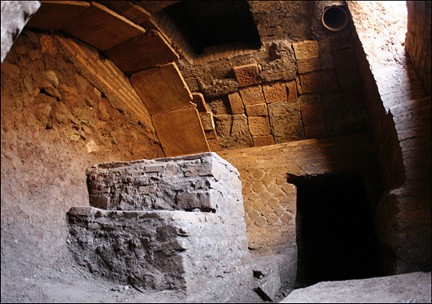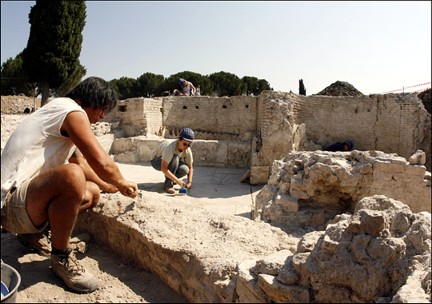Hallada una villa de recreo para multimillonarios en Roma
Photo: Ancient Spa. A view of the 2nd-century bath complex believed to be part of a vast, luxurious residence of a billionaire who gathered his fellow Romans to party and relax. AP Photo/Andrew Medichini
Un grupo de arqueólogos ha descubierto una mansión para magnates a las afueras del centro de Roma que estaba dotada de su propio complejo de baño, el equivalente en la Antigua Roma a la posesión de una flota de Ferraris o un jet privado.
"Éste es un complejo de baño muy impresionante y muy bien conservado que perteneció a Quintus Servilius Pudens, un multimillonario amigo del emperador Adriano", dijo Darius Arya, un arqueólogo estadounidense que está dirigiendo las excavaciones.
El yacimiento de la Villa delle Vignacce, junto al aeropuerto de Ciampino, al sur de Roma, fue explorado por primera vez en 1780 por un grupo de arqueólogos que encontró estatuas que hoy día pueden verse en el museo del Vaticano.
Pero sólo ahora que el área, situada en el centro de un parque de la periferia, ha sido propiamente excavada, se han revelado no sólo los previsibles muros, suelos y portales de la villa de múltiples plantas, sino también el sorprendente hallazgo de los lujosos baños.
"Es muy impresionante haber descubierto algo así de bien preservado en este día y esta era", manifestó Arya, señalando el suelo de marfil del caldarium de la villa, una habitación similar a la sauna que era calentada por aire caliente introducido entre los muros desde un horno alimentado por los esclavos del dueño de los terrenos.
La habitación también disponía de una bañera de agua caliente, aunque el caldero de bronce usado para mantener el agua de baño a una elevada temperatura fue extraído hacía mucho tiempo por los saqueadores.
La villa muestra muchos signos de daños similares, como fragmentos de marfil abandonados después de que la valiosa piedra se desprendiera de los muros cuando la villa cayó en desuso. La última vez que fue usada fue probablemente en el siglo VI d.C., convertida en una fortaleza por los Godos que saquearon Roma.
Cerca del caldarium están las letrinas comunes, donde una docena de invitados podían realizar sus necesidades fisiológicas mientras disfrutaban de compañía y conversación.
Servilius, que probablemente hizo su fortuna fabricando bloques (uno de los principales materiales de las construcciones romanas), habría usado los baños para celebrar lujosas fiestas para impresionar a sus amigos, explicó Arya, presidenta del Instituto Estadounidense de Cultura Romana.
"Él quiere tener cientos de fiestas, quiere mostrar al mundo toda su riqueza y sofisticación", añadió.
No todo el mundo estaba invitado. En la parte más profunda de la excavación, túneles subterráneos evidencian el lugar donde los esclavos de la villa trabajaban, escondidos a la vista de las clases altas que disfrutaban de su tiempo libre sobre los suelos de mosaicos de la parte de arriba.
Fuente: Robin Pomeroy, Roma. Reuters. 24 de julio de 2007
Enlace: http://es.today.reuters.com/news/newsArticle.aspx?type=entertainmentNews&storyID=2007-07-24T172955Z_01_SAN462262_RTRIDST_0_OESEN-ARQUEOLOGIA-ROMA-BANOS.XML
(2) Ancient Roman Baths Unearthed
A large 2nd-century bath complex believed to be part of a wealthy Romans luxurious residence has been partially dug up, archaeologists said Thursday.
The exceptionally well-preserved two-story complex, which extends for at least five acres, includes ornate hot rooms, vaults, changing rooms, marble latrines and an underground room where slaves lit the fire to warm the baths.
Statues and water cascades decorated the interiors, American archaeologist Darius A. Arya, the excavations head, said during a tour offered to The Associated Press on Thursday. Only pedestals and fragments have been recovered.
Arya spoke as students and experts were brushing off dirt and dust from ancient marbles, mosaic floors and a rudimentary heating system, made of pipes that channeled hot air throughout the complex.
"The Romans had more leisure time than other people, and its here in the baths that they typically spent their time," Arya said. "Because you could eat well, you could get a massage, you could have sex, you could gossip, you could play your games, you could talk about politics you could spend the whole day here."
However, he added, "to have a bath complex of this size, this scale, its very unusual."
The complex was believed to be part of a multi-story villa that belonged to the Roman-era equivalent of a billionaire, a man called Quintus Servilius Pudens who was a friend of Emperor Hadrian, Arya said. It was unclear whether the baths were open to the public or reserved for the owners distinguished guests.
Photo: Digging Deeper. Archaeologists work on bath complex ruins. The two-story complex, which extends for at least 5 acres, includes exceptionally well-preserved decorated hot rooms, vaults, changing rooms with benches, as well as marble latrines and an underground room where slaves lit the fire to warm the baths. AP Photo/Andrew Medichini
"These people lived a magnificent existence and were able to provide entertainment" to others, said Arya, also a professor at the American Institute for Roman Culture.
Excavations at the Villa delle Vignacce park lasted a total of 10 weeks and will continue, he said. It has not yet been decided whether it will be open to the public.
Ancient Romans put a great deal of emphasis on bathing, turning the art of the soak into a ritual. Meeting at communal bath houses, they went through a series of rooms of alternating temperatures at a leisurely pace, dipping themselves in hot and cold baths. Bathing was a social event as well as a way to purify the body and relax.
Source: Marta Falconi, Associated Press, July 20, 2007
Link: http://dsc.discovery.com/news/2007/07/20/romanbath_
arc_02.html?category=archaeology&guid=20070720091530


0 comentarios